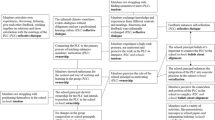Abstract
This discussion explores the journal’s special issue from the construct of ownership and how it relates to participatory design. I examine the articles of researchers from Europe and the United States which offer data-centered perspectives and data-driven suggestions. These works suggest how to best involve different stakeholders and I examine how these initiatives can affect participants’ ownership giving voice to change for the future.
Similar content being viewed by others
References
Benton, L., & Johnson, H. (2014). Structured approaches to participatory design for children: Can targeting the needs of children with autism provide benefits for a broader child population? Instructional Science. doi:10.1007/s11251-013-9297-y.
Cook-Sather, A. (2014). Multiplying perspectives and improving practice: What can happen when undergraduate students partner with college faculty to explore teaching and learning? Instructional Science. doi:10.1007/s11251-013-9292-3.
Cornelius, L. L., & Herrenkohl, L. R. (2004). Power in the classroom: How the classroom environment shapes students’ relationships with each other and with concepts. Cognition and Instruction, 22(4), 467–498.
Goeze, A., Zottmann, J., Vogel, F., Fischer, F., & Schrader, J. (2014). Getting immersed in teacher and student perspectives? Facilitating analytical competence using video cases in teacher education. Instructional Science. doi:10.1007/s11251-013-9304-3.
Janssen, F., Westbroek, H., & Van Driel, J. (2014). How to make guided discovery learning practical for student teachers. Instructional Science. doi:10.1007/s11251-013-9296-z.
Könings, K. D., Seidel, T., Brand-Gruwel, S., & Van Merriënboer J. J. G. (2014). Differences between students’ and teachers’ perceptions of education: Profiles to describe congruence and friction. Instructional Science. doi:10.1007/s11251-013-9294-1.
Mann, S. J. (2001). Alternative perspectives on the student experience: Alienation and engagement. Studies in Higher Education, 26(1), 7–19.
Pierce, J. L., Rubenfeld, S., & Morgan, S. (1991). Employee ownership: A conceptual model of process and effects. The Academy of Management Review, 16(1), 121–144.
Sharples, M., Taylor, J., & Vavoula, G. (2010). A theory of learning for the mobile age. In B. Bachmair (Ed.), Medienbildung in neuen Kulturräumen (pp. 87–99). Stuttgart: Kohlhammer Verlag.
Shulman, L. (2004). Teaching as community property: Putting an end to pedagogical solitude. Teaching as community property: Essays on higher education 140–144. San Francisco, CA: Jossey-Bass.
Yip, J. C., Clegg, T. L., Bonsignore, E., Gelderblom, H., Lewittes, B., Guha, M. L., & Druin, A. (2012). Kitchen chemistry: Supporting learners’ decisions in science. In J. van Aalst, K. Thompson, M. J. Jacobson & P. Reimann (Eds.), Proceedings of the Tenth International Conference of the Learning Sciences (ICLS 2012), 1 (pp. 103–110). Mahwah, NJ: Erlbaum.
Author information
Authors and Affiliations
Corresponding author
Rights and permissions
About this article
Cite this article
Druin, A. Inclusive ownership of participatory learning. Instr Sci 42, 123–126 (2014). https://doi.org/10.1007/s11251-013-9307-0
Received:
Accepted:
Published:
Issue Date:
DOI: https://doi.org/10.1007/s11251-013-9307-0




